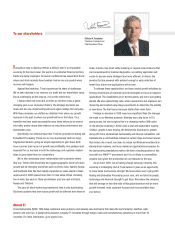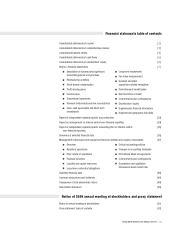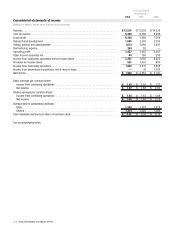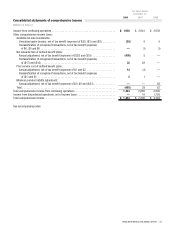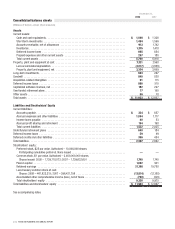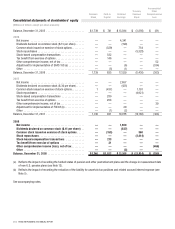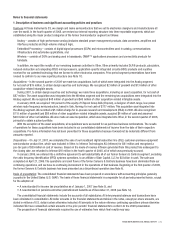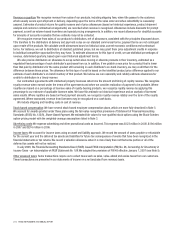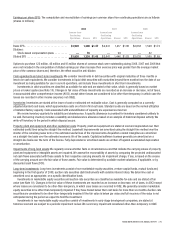Texas Instruments 2008 Annual Report Download - page 9
Download and view the complete annual report
Please find page 9 of the 2008 Texas Instruments annual report below. You can navigate through the pages in the report by either clicking on the pages listed below, or by using the keyword search tool below to find specific information within the annual report.
TEXAS INSTRUMENTS 2008 ANNUAL REPORT [ 7 ]
Notes to financial statements
1. Description of business and significant accounting policies and practices
Business: At Texas Instruments (TI), we design and make semiconductors that we sell to electronics designers and manufacturers all
over the world. In the fourth quarter of 2008, we revised our internal reporting structure into three reportable segments, which are
established along the major product categories of the former Semiconductor segment as follows:
Analog – consists of high-performance analog (includes standard power management products, data converters, amplifiers and
interface products) and high-volume analog & logic,
Embedded Processing – consists of digital signal processors (DSPs) and microcontrollers used in catalog, communications
infrastructure and automotive applications, and
Wireless – consists of DSPs and analog used in basebands, OMAP™ applications processors and connectivity products for
handsets.
In addition, we report the results of our remaining business activities in Other. Other primarily includes DLP® products, calculators,
reduced-instruction set computing (RISC) microprocessors, application-specific integrated circuits (ASIC) products and royalties
received for our patented technology that we license to other electronics companies. Prior period segment presentations have been
revised to conform to our new reporting structure (see Note 17).
Acquisitions – In the second quarter of 2008 we made two acquisitions, both of which were integrated into the Analog segment,
for net cash of $19 million, to obtain design expertise and technology. We recognized $2 million of goodwill and $13 million of other
acquisition-related intangible assets.
During 2007, to obtain design expertise and technology, we made three acquisitions, including an asset acquisition, for net cash of
$87 million. The asset acquisition was integrated into the Wireless segment and the remaining two acquisitions were integrated into the
Analog segment. We recognized $48 million of goodwill and $45 million of other acquisition-related intangible assets.
In January 2006, we acquired 100 percent of the equity of Chipcon Group ASA (Chipcon), a designer of short-range, low-power
wireless radio frequency semiconductors, based in Oslo, Norway, for net cash of $177 million. This acquisition was integrated into
the Analog segment. We recorded a $5 million charge for in-process research and development (R&D) in 2006. We also recognized
$115 million of goodwill and $86 million of other acquisition-related intangible assets, acquired $6 million of cash and assumed
$29 million of other net liabilities. We also made an asset acquisition, which was integrated into Other, in the second quarter of 2006,
primarily to obtain a patent portfolio.
With the exception of the asset acquisitions, all acquisitions were accounted for as purchase business combinations. The results
of operations for these acquisitions have been included in our consolidated statements of income from the date of their respective
acquisitions. Pro forma information has not been presented for these acquisitions because it would not be materially different from
amounts reported.
Dispositions – On July 31, 2007, we completed the sale of our broadband digital subscriber line (DSL) customer-premises equipment
semiconductor product line, which was included in Other, to Infineon Technologies AG (Infineon) for $61 million and recognized a
pre-tax gain of $39 million in cost of revenue. Based on the levels of revenue Infineon generated from this product line subsequent to
the closing date, we refunded to Infineon $16 million in the fourth quarter of 2008, all of which was previously accrued.
In January 2006, we entered into a definitive agreement to sell substantially all of our former Sensors & Controls segment, excluding
the radio frequency identification (RFID) systems operations, to an affiliate of Bain Capital, LLC for $3 billion in cash. The sale was
completed on April 27, 2006. The operations and cash flows of the former Sensors & Controls business have been eliminated from our
continuing operations, and we have no continuing involvement in the operations of that business. Beginning in the first quarter of 2006,
the former Sensors & Controls business has been presented as a discontinued operation (see Note 6).
Basis of presentation: The consolidated financial statements have been prepared in accordance with accounting principles generally
accepted in the United States (U.S. GAAP). The basis of these financial statements is comparable for all periods presented herein, except
for the adoption of:
•AnewstandardforincometaxuncertaintiesasofJanuary1,2007(seeNote5),and
•AnewstandardonpensionsandotherpostretirementbenefitsasofDecember31,2006(seeNote12).
The consolidated financial statements include the accounts of all subsidiaries. All intercompany balances and transactions have
been eliminated in consolidation. All dollar amounts in the financial statements and tables in the notes, except per-share amounts, are
stated in millions of U.S. dollars unless otherwise indicated. All amounts in the notes reference continuing operations unless otherwise
indicated. We have reclassified certain amounts in the prior periods’ financial statements to conform to the 2008 presentation.
The preparation of financial statements requires the use of estimates from which final results may vary.


